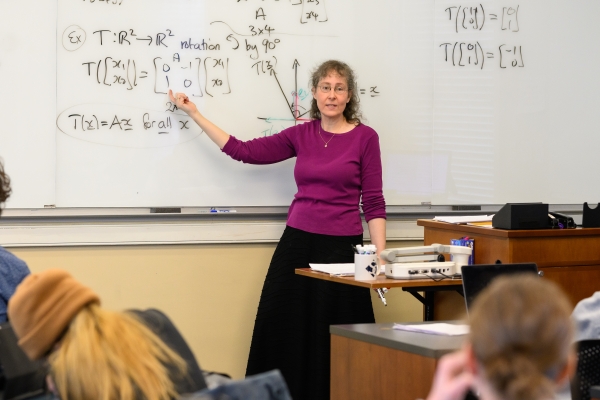Mathematics Professor Elizabeth Denne Featured in Quanta Magazine Article The article focuses on the geology and topology behind optimal shapes.
Elizabeth Denne, professor of mathematics at Washington and Lee University, was featured in an article titled “Mathematicians Identify the Best Versions of Iconic Shapes” that ran in the January edition of the online publication Quanta Magazine.
The article, written by Kevin Hartnett, references the study of optimal shapes and involves understanding which version of a shape best achieves a goal given some constraints. The theory of optimal shapes bridges geometry and topology and explores the fundamental properties of mathematical objects. This often deals with idealized objects that are endlessly stretchable and compressible.
Hartnett’s piece focuses primarily on Möbius strips and trefoil knots. A Möbius strip can be created by taking a strip of paper, twisting it, and then joining the ends. Trefoil knots are achieved similarly to tying a shoelace. One would make a loop in a piece of rope and pull one end through. However, instead of tying the bow, the rope ends are simply glued together to form an overhand knot with two loose ends connected.
In topology, Möbius strips of different sizes are interchangeable, since a small strip can be stretched into a big one, a wide one squished into a skinny one and so forth. Hartnett examines how far the limits of topology can expand, asking “how much can you squeeze before it becomes impossible to go any further?”
A specialist in topology, Denne then offers the quote, “One question is, what is the least length, and the other is, is there a way to attain that least length and what does it look like.”
Later in the article, the author explores optimal shapes that aren’t associated with Möbius strips, pondering how much material would be needed to make different kinds of knots. He references work performed in 2020 by Denne and two of her students, John Carr Haden ’22 and Troy Larsen ’22, where they studied folded ribbon knots. A simple example of this would involve joining the two loose ends of a common overhand knot, resulting in a knotted loop.
Denne and her students found two better ways to tie a ribbon into a trefoil knot, and the author examines their work to explain how this is achieved. The article then concludes with another quote from Denne.
“Everyone can get a piece of paper and put a twist in it and play with it and get a feeling for math,” she said. “There’s something about this kind of math problem that lets you do some deep thinking starting with a very basic question.”
Denne joined the W&L faculty in 2012 as an assistant professor and was promoted to associate professor in 2015 and professor in 2022. She received a Bachelor of Science in pure mathematics from the University of Sydney and obtained a Ph.D. in mathematics from the University of Illinois, Urbana-Champaign.
If you know a W&L faculty member who has done great, accolade-worthy things, tell us about them! Nominate them for an accolade.
 Elizabeth Denne, professor of mathematics
Elizabeth Denne, professor of mathematics
You must be logged in to post a comment.